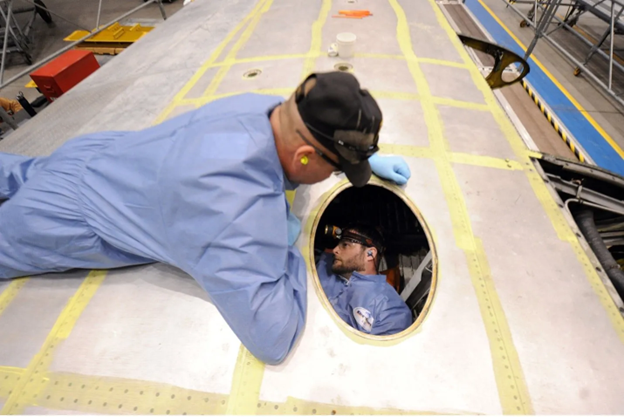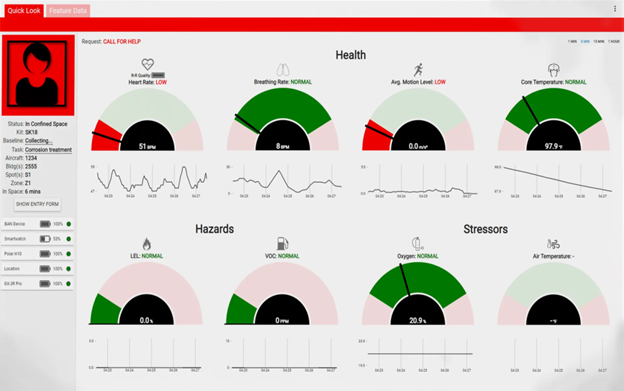Contributor: Sentinel

Safety leaders hope to never receive the news that co-workers are injured but, unfortunately, it happens. Workplace deaths may result from sudden accidents or long-term complications.
That’s why more organizations are turning to technology. Organizations and workers benefit from having data insights to prevent injuries and predict workers’ future health risks.
Take for example the confined space operations of the US Air Force Air Logistics Complexes.

Air Force Air Logistics Complexes (ALCs)
Maintaining a fleet of aircraft is a resource-intensive process. Every day, aircraft maintenance personnel monitor confined spaces. The confined space is tested for toxic conditions before a maintenance worker may enter to do repairs. During this time, each worker within a confined space is observed by a safety attendant as dictated by Air Force safety policies along with broader Occupational Safety and Health Administration (OSHA) regulations.
Multiple people and high labor costs are needed to complete this process. While it effectively prevents incidents, there’s also natural human limitations. For example, safety attendants often cannot view the entire confined space or hear cues due to high noise levels and ear protection.
That’s why the Air Force Research Laboratory funded contracts to create an advanced “confined spaces monitoring system.”
After much effort in research and development, Sentinel was formed to commercialize a sensors-based, remote monitoring and alerting platform. Workers can now wear a sensor suite that provides data for continuous monitoring of each person’s physiological status and exposure to atmospheric conditions, among other health and safety data. This also allows a remotely stationed safety attendant to monitor all of the aircraft maintenance personnel through a single dashboard versus needing a one-to-one safety attendant for maintenance personnel supervision.
But the Air Force isn’t the only organization using a combination of technologies to more effectively prevent risk and injury. You can read more stories here. What is the combination of technologies that make up this sensors-based, remote monitoring and alerting platform? It can be narrowed down to three main components.
The Technologies Improving Occupational Safety Efforts
Flexible Wearables and IoT (Internet of Things)
Wearables and IoT offer data on users’ habits and health, but teams and organizations have struggled to make the best use of the information. One reason is that workers also need smaller, flexible wearables that fit their active, and often strenuous activities.
The other reason is that different devices and brands often don’t integrate to provide contextual insights. No one has time to toggle between multiple product dashboards (i.e., smartwatches and other sensors) and piece together the data for every team member. For example, someone’s Apple watch may show that their heart rate spiked at 3 pm, but with no other context, while data from another sensor may show an increase in physical activity or exposure to a toxicant.
Do your employees already wear smartwatches? Or, do they use fitness apps? Perhaps you already invest in wearables or IoT for your staff. Now, there is a possibility to correlate the data across products. This brings us to the topic of how to easily make that integration work for your company operations.
Product Integration for Proactive, Preventative Insights
Most occupational safety devices only alert when an injury, accident, or exposure has already occurred.
Workers need proactive, preventative insights that alert them when an injury or illness from long-term exposure is likely to happen.
For example, instead of alerting a worker or the health and safety team after heat syncope, alert when someone is showing signs that a heat stroke could occur so that early or even preventive care can be provided.
This level of sophisticated monitoring is possible when you connect a variety of wearables, sensors, and IoT devices across brands into a single, intelligent system powered by artificial intelligence (AI) and edge processing. With integration into this system, you receive personalized, predictive, and contextual insights into the physiological and environmental conditions of different people and teams.

Reliable Device Communication
People don’t always work within buildings, established outdoor spaces, or where human oversight and modern communication technology are available. They can be in secluded areas like fields or, as shared in the opening story to this article, in confined and noisy spaces where human oversight is difficult and risky.
Even if workers are wearing or using occupational safety equipment, they are often where there is limited to no cellular service or Wi-Fi. This is why industry-wide efforts are being made to test solutions based on SATCOM and LPWAN technology so that occupational safety wearables and devices can communicate with outside sources even in remote areas.
How Sentinel Helps Organizations Predict and Prevent Risk and Injury
In the past five years, we’ve been working on government-funded contracts to develop technology for multiple aspects of a Confined Spaces Monitoring System (CSMS).
This workforce health and safety monitoring system has continued to mature through multiple funding efforts and technology milestones. The system is now known as SafeGuard™ and uses cutting-edge technology including AI-powered analytics, military-grade cybersecurity, and the latest in wearable sensors to provide continuous and real-time monitoring for your team.
We look forward to having conversations with company leaders around health and safety policies and procedures along with related VPPPA perspectives and Occupational Safety and Health Administration (OSHA) regulations.